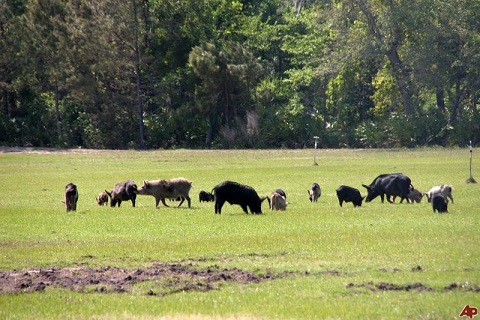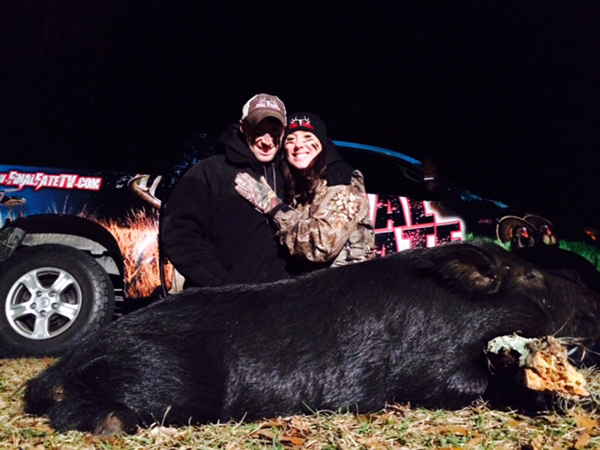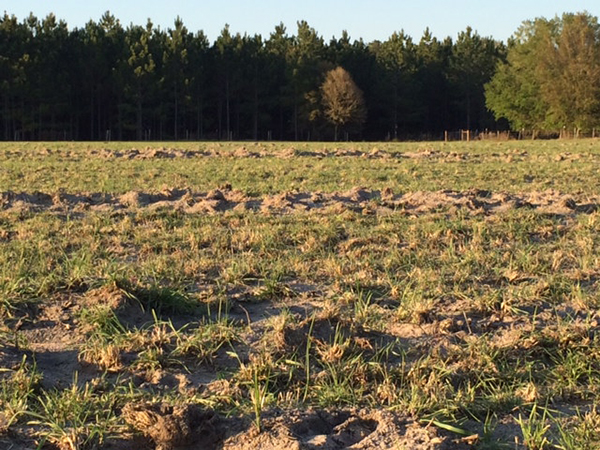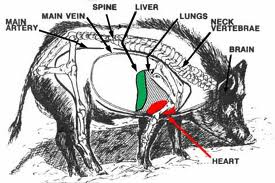LAST UPDATED: May 1st, 2015
The weather forecast showed a slight chance of rain and clouds and a wind that was pushing in from the East. I smiled and told my hunting partner Jason Daniel that he better have the cameras charged because all of the conditions were right for a perfect hog hunt in one of my favorite bow stands.
As we settled into the stand I had that feeling of overwhelming confidence that it was going to be an amazing evening filled with memories and pork chops. I was half way through my opening interview with the cameras rolling when I heard the familiar sound of swamp water splashing under the feet of several beautiful Sunshine State wild hogs. I was able to put my Mathews bow to work that day harvesting not one, but two healthy porkers.
As a result of their destructive nature, hogs offer a fantastic opportunity for bowhunters.
Growing up in West Virginia I had no idea how amazing, dangerous and down right destructive wild hogs could be. However, I have since learned just how damaging they can be. In this article we will take a look at the impact wild hogs has on our agriculture as well as how they affect our native wildlife.
The Origin of the Wild Hog
The debate over the amount of devastation to agriculture from wild hogs is nothing new. Wild hogs (or Feral Swine) have been causing problems for farmers since their inception during the 1500’s by Spanish explorer, Hernando Desoto. In the centuries that followed European exploration and the colonization of the eastern United States wild hogs began to thrive and due to poor management practices they spread throughout the country. In reality these hogs were brought to the Americas under a domesticated label. The early 1900’s are where the interbreeding of the domestic stock introduced by the early Europeans and the Eurasian wild boars, which were introduced for hunting purposes, took place to cultivate the massive infestation of the hybrid population we see today.
The range of the wild hogs today is estimated to cover nearly 45 states. Populations of wild hog exist as far north as Michigan, North Dakota, and Oregon. However, this wide spread coverage is due mostly to illegal transportation of the wild hog to various locations by humans.
The Cost of Wild Hogs
The introduction of the wild hog has come with a price tag. Farmers and landowners have felt the huge impact of these animals often referred to as “nuisance animals”. The conservative estimate of damage caused by wild hogs to agriculture and the environment currently stands at $1.5 billion annually. As the cliche goes, “Houston we have a problem!” Today free-ranging hogs are considered to be wild and therefore labeled as a “Nuisance animal” based on their ability to decimate agriculture, native wildlife, and the environment. The nature of this beast has sparked much concern to the authorities based on the reports and complaints of farmers and landowners.
Feral hogs can damage agriculture by “rooting” or digging for the source of the crop such as root systems and seeds. Wild hogs tend to gravitate to crops such as peanuts, corn, potatoes, soybeans, turnips, as well as other cash crops. These types of planted food sources provide the hog with nutrients to sustain the fast paced life they lead as well as the breeding cycle, which can be upwards of three litters of piglets from one sow in one season.
The author and his wife after a successful evening hunting wild hogs in Florida.
Other dangerous conditions exist long after the wild hog has destroyed an area. Livestock can inquire injury from the rooting and digging which create massive holes in the soil. Farmers also experience equipment damage from the uneven ground, not to mention the time, money, and energy it takes to re-cultivate the destruction the wild hogs leave behind. Wild hogs do pose a threat to native species such as deer and turkeys. Obviously the wild hog is an eating machine consuming 5% of their body weight per day. The diet they thrive on is made up of 85% to 90% vegetation with the rest being made up of animal matter. Wild hogs are opportunistic omnivores, meaning they consume both plant and animal matter. With this being said, the concern arises for the health and well being of our native species.
Beyond Wildlife
Two key concerns that directly associate with our native wildlife and our environment is the adverse affect hogs have on our water and soil. Rooting, wallowing, and trampling contributes to the spread of invasive plant species as they grow quicker than many native plant systems. Wild hogs love the feel of cooling water on their body. Wallowing in streams, lakes, and ponds is a fairly common occurrence in areas of hog population. This practice can result in excessive silt and bacterial distribution into our waterways and more so into the available water sources for livestock. Over time, the bacteria related to wild hogs in the water can affect native aquatic life, amphibians, and most notably fish. One other concern is the fecal matter of wild hogs, which elevates the fecal coliform concentrations, which can bring the water to a dangerous level, exceeding human health standards.
The author’s farm in Florida and the damage Wild Hogs placed on the peanut harvest.
Danger Of Disease
One concern that is not normally noted when discussing wild hogs is their ability to carry disease. Wild hogs are associated with two primary types of infectious diseases. The first is called, Brucellosis, which is found in both humans and animals. Clinically, this disease resembles severe flu, crippling arthritis, or even meningitis. This disease is treated with high doses of antibiotics. Another notable disease carried by feral hogs is Pseudorabies, which is a viral disease of the central nervous system. Anorexia, convulsions, and spasms can be incorporated with this disease.
One Man’s Trash
Since I have described the negative side of the wild hog I feel it is time to let you in on the exciting side! When I moved to Florida I soon realized there was a tasty animal I could bow hunt 24 hours a day, 7 days a week, 365 days a year. As any West Virginia hillbilly would say, sign me up for that! Shortly after moving I became infatuated with hunting wild hogs. I wanted to learn about them, be around them and discover how to effectively harvest them with a bow on a frequent basis.
Getting started hunting hogs was the toughest part for me so I want to discuss the various options and opportunities you have to harvest your own wild boar. If you live in a state that has a thriving hog population you may be able to find farmers or landowners that will gladly allow you to hunt what is to them a huge nuisance. The fact that you are bowhunting is a plus due to the fact that many cattle and horse farmers do not like the thought of someone toting a gun within close proximity of their income. Another option is to link up with a good outfitter. In short, a knowledgeable guide can make your hog hunting experience much more enjoyable.
Scouting
Once you have established a place to hunt, whether with a landowner or an outfitter, treat the hunt as you would any other. I suggest spending time glassing areas of frequent activity such as food sources, wallows, and areas with fresh sign. Trail cameras can be a huge addition in your quest to find huntable hogs. If hogs are in the area they will visit food sources often. This type of scouting will allow you to develop a game plan to get close and capitalize on a walking pork sandwich.
Gear For Piggy
Gear can be the most critical part of the hog hunting process. Hogs are without a doubt the toughest animals I have ever tried to harvest with a bow. One major key to consider is the kinetic energy of your arrow. You want to maximize arrow penetration on these animals for the best results. They have a tremendously tough layer of combined fat, skin, and hair that you must negotiate in order to make a lethal shot. Also, quality scent control is paramount to success. The majority of my hunts that have had a negative result were due to the hog catching my wind. You must have the wind in your favor as well as taking every scent elimination step seriously.
Shot Placement
Bowhunters know that typically we strive for the perfect broadside or quartering away shot on game but in certain situations exceptions can be made to acquire lethal arrow placement. This is not the case with wild hogs. I cannot stress enough the importance of shot placement on these amazingly resilient animals. Any shot other than a perfect broadside or quartering away shot on a wild hog decreases your chances for recovery by nearly 75%. Patience is a must!
When trying to place and arrow into the sweet spot of a wild hog it is important to be mindful of the protective gear that the animal “naturally” carries.
Lights Out
Keep in mind that wild hogs can be harvested in many states with the use of lights. This makes for some exciting nights! I typically use mounted lighting systems on my bow that illuminate the hogs enough to make an ethical shot. A red or green color light is best. Typically, hogs are nocturnal by nature so hunting at night can be the best opportunity you have at harvesting a mature wild boar.
In closing, I hope that you have a better understanding of the wild hog and the dilemma our country faces due to their destructive habits. In spite of this, the door is wide open for bowhunters. Together we can help make a difference by harvesting as many of these animals as we can. I think of hogs much like I do Lebron James, you can’t stop them, you can only hope to contain them.










